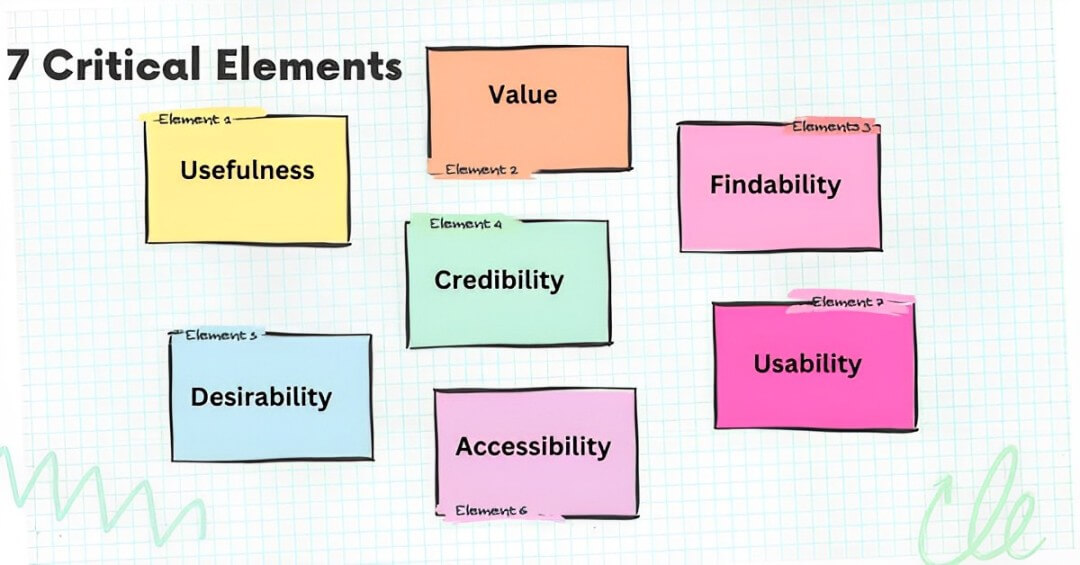
User experience is one of the critical components that get factored into how successful a digital product will be. It has to do with user satisfaction, retention, and engagement directly. There are some key elements of the user’s experience that really help in improving dramatically the way users interact with your application or website. This would be the critical elements to remember in design, as this would help in retaining customers by promoting repeat businesses and driving conversions through better user experiences.
Imagine a website that pleases the eye and just flows right in such a way that it smoothly aids you toward the information you are seeking. That is what considerate, good UX design is about—what sets your product apart in a crowded digital landscape. We will look at seven of the key elements in this article, which could enhance your User Experience, and provide practical insight into how these can be effectively applied.
1, Usefulness
Now, the first major element in the User experience is one of usefulness. Your product has to be useful to them, help them to fulfill their needs, and solve their problems. Whether your application is practical, entertaining, or informative in purpose, users have to see a point in using it, especially the target audience.
Knowing precisely what needs and pain points your users have is going to help you create more utility. This understanding is, hence, going to inform design decisions, and thus it shall ensure that the product would still turn out relevant and useful for its users.
2, Usability

Usability is how painless and intuitive your product is in use. A really usable product is one that allows users to realize, without much frustration, their objectives at hand. Clean up the interface, organize, instruct, and simplify features that may overwhelm.
Run usability testing to obtain feedback from real users—be sure to identify where users may be having problems. In working through these issues, you will have a much more intuitive feel for what users want to do and how to meet those expectations.
3, Findability
Findability refers to the degree to which the user can locate the information or features he needs in your product. It happens to be pretty important for the creation of an organized interface that has its navigation exposed. Any user should be able to go through your application or website easily and effortlessly without hassle or confusion.
Establish a logical structure of the content with good search functionality to support findability. This shall include terms and labels recognizable and meaningful to the target audience so they will be able to find needed content.
4, Credibility
Credibility sets in the base of trust between users and a product. The credible product is the one that gives proof of truthful, relevant information and of expertise within the domain of its subject matter. This can play a large part in user engagement and user retention.
By professional branding, positive user reviews, and transparency in communicating and thus establishing credibility, clearly mention contact information. Top customer support can be included here to build trust in the product.
5, Desirability
Desirability is the emotional plea of a product. A product that is desirable doesn’t only meet the needs of users, but also creates loyalty, positive word-of-mouth, and every other good result that comes from a product being enjoyed by users. Giving more focus to aesthetics and the look and feel will make it desirable.
Emphasize aesthetics, branding, and storytelling to create a desirable experience. Sleek design elements will speak to your audience and reverberate, eliciting that fuzzy feeling. Then, create a story around your product touting the benefits and relating it to them personally.
6, Accessibility

In this way, one ensures the ease of use by all, whether one has any form of disability or not. Accessible designs prove helpful in every given situation, and it will increase your target group of users. It makes it easy for every user and shows that you really do care about the general user experience.
For improvements in accessibility, follow the normal guidelines prescribed by WCAG. Implement screen reader, high contrast modes, and keyboard navigation to make things more accessible.
7, Value
The last of the critical elements is value, which stretches from user satisfaction to business objectives. For a product to be considered successful, it has to create value for the user; at the same time, it should create value for your company’s goals. If a person wishes to be successful over a long period, one has to balance between the two very delicately.
Value shall be created if you watch what the user needs then let that drive your business objective. Keep gathering feedback from the users, analyse data to find moments for improvements so that the product keeps bringing value to the users and your firm.
Conclusion
What this more fundamentally means is that the improved user experience, in reality, forms the very basis of scoring success with any digital product. Remember these seven key elements: usefulness, usability, findability, credibility, desirability, accessibility, and value bound together, and thereby create an interrupted engaging experience that matches the needs of users and drives satisfaction.
As you begin to work in adaptations of these elements into your design processes, remember to user-center your decisions. It is continued feedback and adaptation to user preference that makes a product relevant and useful in a constantly changing digital world. Practice them today and watch your user experience grow!
Frequently Asked Questions
1, What are the elements of user experience?
Some key constituents revolving around a good user experience include; usefulness, usability, findability, credibility, desirability, accessibility, and value. The mentioned aspects of a UX afford an active and engageable user experience accosted to it.
2, How can I make my product more usable?
Several ways can be adapted to increase your product usability; a list of a few includes: Usability testing, Simplify your interface, Instructions for users, Intuitive and user-friendly design, and Easy to use.
3, Why is accessibility important in user experience design?
In design, this is vital for making sure all users, including those with other abilities, use your product according to their capabilities. Accessible design does not mean a larger audience; it is more of a socially responsible call to become even more inclusive.







